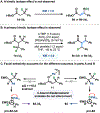Comprehensive Mechanistic Analysis of Palladium- and Nickel-Catalyzed α,β-Dehydrogenation of Carbonyls via Organozinc Intermediates
- PMID: 38377547
- PMCID: PMC11000628
- DOI: 10.1021/acs.joc.3c02572
Comprehensive Mechanistic Analysis of Palladium- and Nickel-Catalyzed α,β-Dehydrogenation of Carbonyls via Organozinc Intermediates
Abstract
Introducing degrees of unsaturation into small molecules is a central transformation in organic synthesis. A strategically useful category of this reaction type is the conversion of alkanes into alkenes for substrates with an adjacent electron-withdrawing group. An efficient strategy for this conversion has been deprotonation to form a stabilized organozinc intermediate that can be subjected to α,β-dehydrogenation through palladium or nickel catalysis. This general reactivity blueprint presents a window to uncover and understand the reactivity of Pd- and Ni-enolates. Within this context, it was determined that β-hydride elimination is slow and proceeds via concerted syn-elimination. One interesting finding is that β-hydride elimination can be preferred to a greater extent than C-C bond formation for Ni, more so than with Pd, which defies the generally assumed trends that β-hydride elimination is more facile with Pd than Ni. The discussion of these findings is informed by KIE experiments, DFT calculations, stoichiometric reactions, and rate studies. Additionally, this report details an in-depth analysis of a methodological manifold for practical dehydrogenation and should enable its application to challenges in organic synthesis.
Conflict of interest statement
The authors declare no competing financial interest.
Figures







References
-
- Knochel P; Molander GA Comprehensive Organic Synthesis; Newnes, 2014.
-
- Miller B; Wong H-S Reactions of 2-Phenylcyclohexanone Derivatives. A Re-Examination. Tetrahedron 1972, 28, 2369–2376.
- Stotter PL; Hill KA α-Halocarbonyl Compounds. II. A Position Specific Preparation of α-Bromoketones by Bromination of Lithium Enolates. Position-Specific Introduction of α,β-Unsaturation into Unsymmetrical Ketones. J. Org. Chem 1973, 38, 2576–2578.
- Reich HJ; Reich IL; Renga JM Organoselenium Chemistry. A-Phenylseleno Carbonyl Compounds as Precursors for α,β-Unsaturated Ketones and Esters. J. Am. Chem. Soc 1973, 95, 5813–5815.
- Sharpless KB; Lauer RF; Teranishi AY Electrophilic and Nucleophilic Organoselenium Reagents. New Routes to α,β-Unsaturated Carbonyl Compounds. J. Am. Chem. Soc 1973, 95, 6137–6139.
- Reich HJ; Wollowitz S Preparation of α,β-Unsaturated Carbonyl Compounds and Nitriles by Selenoxide Elimination. Org. React 1993, 44, 1–296.
- Trost BM; Salzmann TN; Hiroi K New Synthetic Reactions. Sulfenylations and Dehydrosulfenylations of Esters and Ketones. J. Am. Chem. Soc 1976, 98, 4887–4902. For a review, see:
- Newhouse T; Turlik A; Chen Y Dehydrogenation Adjacent to Carbonyls Using Palladium-Allyl Intermediates. Synlett 2015, 27, 331–336.
-
- Ito Y; Hirao T; Saegusa T Synthesis of α,β-Unsaturated Carbonyl Compounds by Palladium(II)-Catalyzed Dehydrosilylation of Silyl Enol Ethers. J. Org. Chem 1978, 43, 1011–1013.
- Theissen R A New Method for the Preparation of α,β-Unsaturated Carbonyl Compounds. J. Org. Chem 1971, 36, 752–757.
- Larock RC; Hightower TR; Kraus GA; Hahn P; Zheng D A Simple, Effective, New, Palladium-Catalyzed Conversion of Enol Silanes to Enones and Enals. Tetrahedron Lett 1995, 36, 2423–2426.
-
- Shimizu I; Tsuji J Palladium-Catalyzed Decarboxylation–Dehydrogenation of Allyl β-Keto Carboxylates and Allyl Enol Carbonates as a Novel Synthetic method for α-Substituted α,β-Unsaturated Ketones. J. Am. Chem. Soc 1982, 104, 5844–5846.
- Shimizu I; Minami I; Tsuji J Palladium-Catalyzed Synthesis of α,β-Unsaturated Ketones from Ketones via Allyl Enol Carbonates. Tetrahedron Lett 1983, 24, 1797–1800.
- Minami I; Takahashi K; Shimizu I; Kimura T; Tsuji J New Synthetic methods for α,β-Unsaturated Ketones, Aldehydes, Esters and Lactones by the Palladium-Catalyzed Reactions of Silyl Enol Ethers, Ketene Silyl Acetals, and Enol Acetates with Allyl Carbonates. Tetrahedron 1986, 42, 2971–2977.
-
- Diao T; Stahl SS Synthesis of Cyclic Enones via Direct Palladium-Catalyzed Aerobic Dehydrogenation of Ketones. J. Am. Chem. Soc 2011, 133, 14566–14569. - PMC - PubMed
- Diao T; Wadzinski TJ; Stahl SS Direct Aerobic α,β-Dehydrogenation of Aldehydes and Ketones with a Pd(TFA)2/4,5-diazafluorenone Catalyst. Chem. Sci 2012, 3, 887–891. - PMC - PubMed
Grants and funding
LinkOut - more resources
Full Text Sources
Miscellaneous

